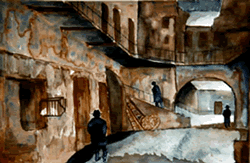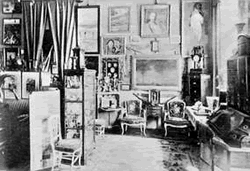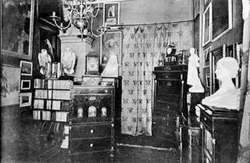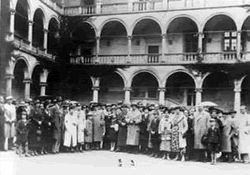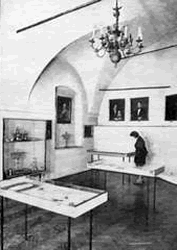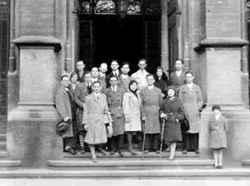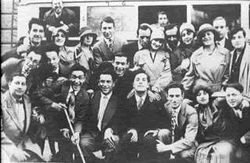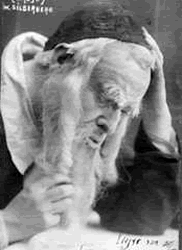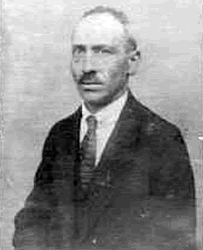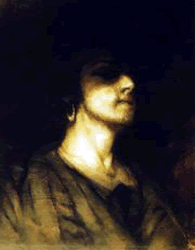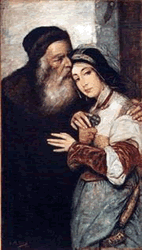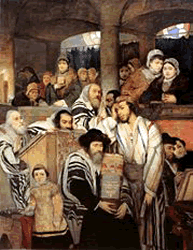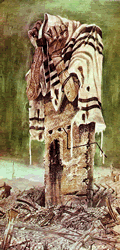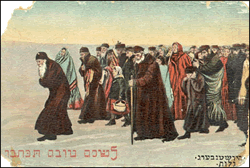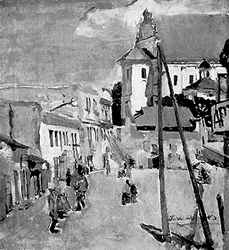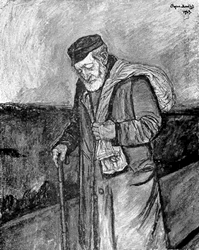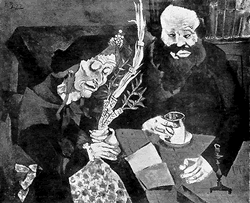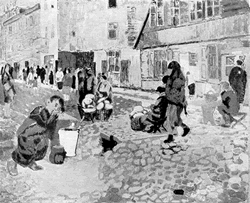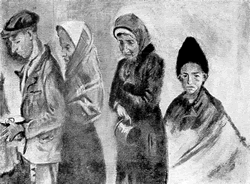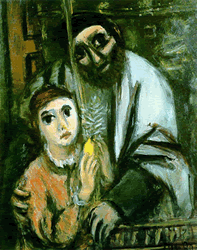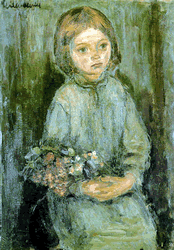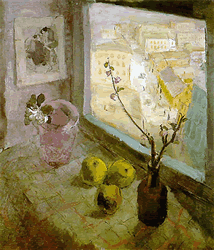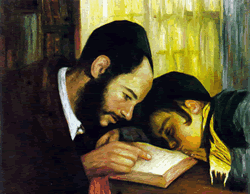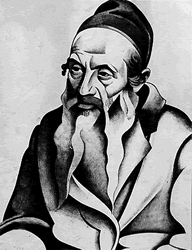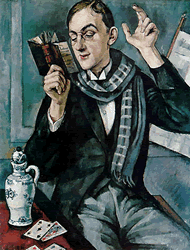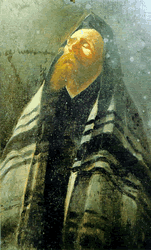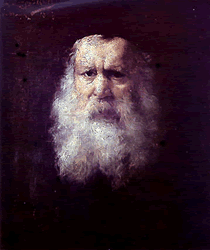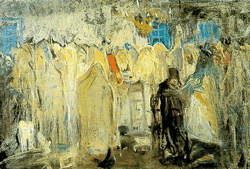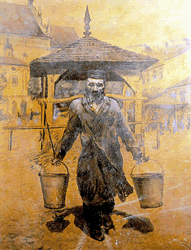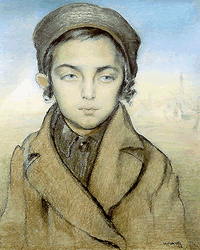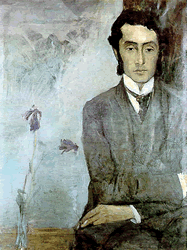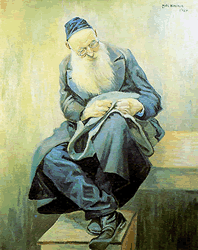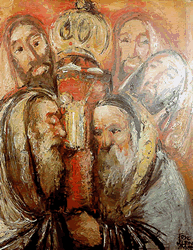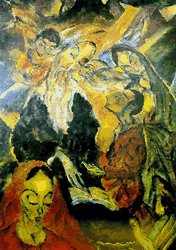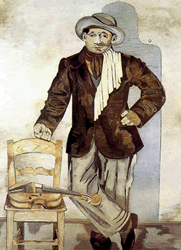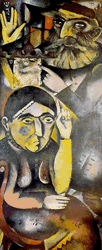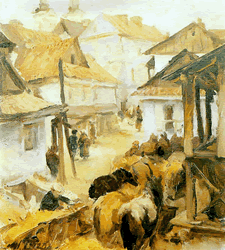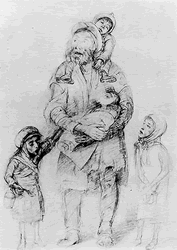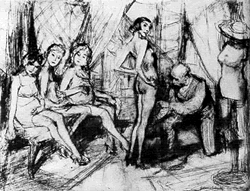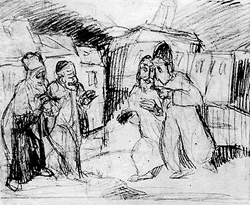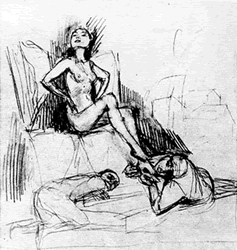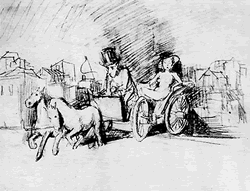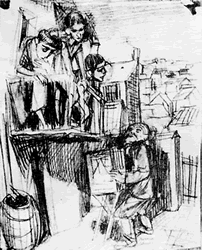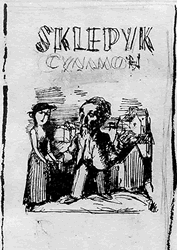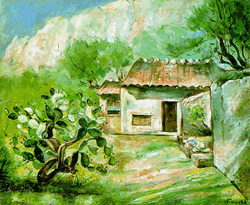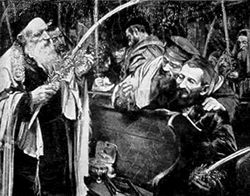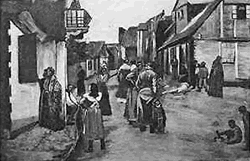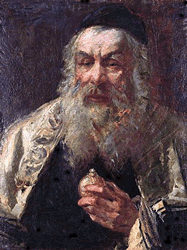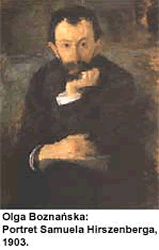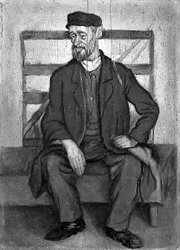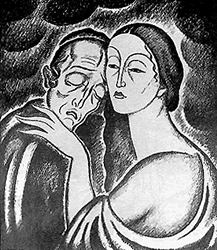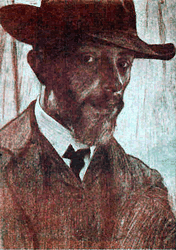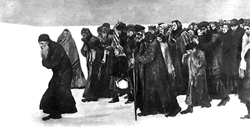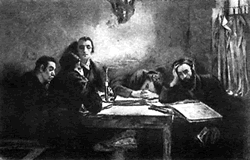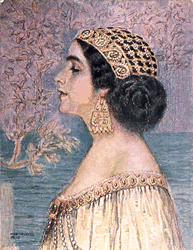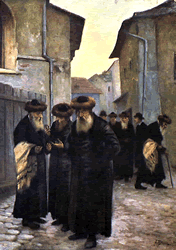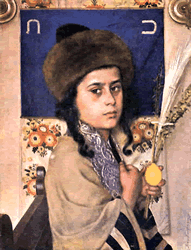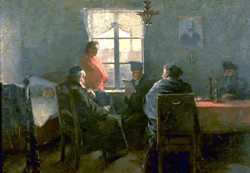| #krkw_art-1: by Dan Kimble |
#krkw_art-2: Model interior of a Polish painter's salon at the F. Jasienskiego Museum. | ||||||
|
#krkw_art-3: Model interior of a Polish painter's salon at the F. Jasienskiego Museum. |
#krkw_art-4: Dr. Mark Dworzecki and other members of the Art and History Lovers of Krakow Antiquities standing in the courtyard of the Wawel Royal Castle. | ||||||
|
#krkw_art-5: The exhibition hall of the old synagogue in Kazimierz |
#krkw_art-6: Members of the Kultur Lige (Culture League) posing on the steps of a public building, 1930 | ||||||
|
#krkw_art-7: The Vilna Troupe and Ararat Yiddish Revue Theater ensemble in front of the Royal Hotel, Cracow, 1929. |
#krkw_art-8: Wolf Silberberg as the 'Tsadik' in the S. Ansky play, "The Dybbuk" |
||||||
#krkw_art-9: Mordkhe Gebirtig (1879-1942), Yiddish folk poet and songwriter |
|||||||
#krkw_art-10 - #krkw_art-59 Cracow 25 June 2008 An exhibition entitled Jewish Artists in Cracow 1873-1939 has opened in the city's Kazimierz district. The exhibition includes works from private collections and 26 Polish museums. It represents a wide cross-section of works by Jewish artists associated with Cracow, either because they were born there, studied in city's Academy of Fine Arts, or later held exhibitions in the city. The new exhibition includes 150 of the most representative works of art by 50 painters, graphic artists and sculptors. The works are diverse, representing almost all styles and trends in Polish and European art during the period. The first part of the exhibition includes works by Jan Matejko's favorite student, Maurycy Gottlieb . The next part shows off work by the most talented Jewish artist from the turn of the 20th century, Samuel Hirszenberg, and pieces by painters associated with him, including Abraham Neuman, Leopold Gottlieb (Maurycy's brother), Jerzy Merkel, and sculptors Henryk Hochman and Henryk Kuna. Works by such artists as Henryk Gotlib, Zygmunt Menkes, Norbert Nadel, Samuel Cygler, Norbert Strassberg, Artur Markowicz and Leon Lewkowicz illustrate the large and dynamic Jewish artistic community in the city during the 1930s. A separate part of the exhibition has been dedicated to those Jewish artists who took part in the most important artistic events organized in Cracow during that period. It includes works by Jewish members of the Sztuka Polish Artists' Society, including formists H. Gotlib and Szymon Müller, and capists Artur Nacht-Samborski and Dorota Berlinerblau-Seydenmann. Until Oct. 31
|
|||||||
| #krkw_art-10 - #krkw_art-12 Maurycy Gottlieb Maurycy Gottlieb, February 21/28 1856–July 17, 1879) was a Jewish painter, of Polish-speaking Galician Jews from the western part of Ukraine. He was born in Drohobych (at that time Austria-Hungary), Galicia, modern Lviv region, western Ukraine. At fifteen, he was enrolled at the Vienna Fine Arts Academy. Later, he would study under Jan Matejko in Kraków. However, he experienced anti-semitism from his fellow students, and left Matejko's studio after less than a year, he then traveled to Norway settling in Molde. After several years he returned to Vienna to pursue his Jewish roots. At twenty, he won a gold medal from a Munich art competition for Shylock and Jessica (at right), showing a scene from Shakespeare's The Merchant of Venice. He based Jessica's face on that of Laura Rosenfeld, to whom he had proposed marriage. However, Rosenfeld rejected his proposal, and wed a Berlin banker. It is believed that he then committed suicide by exposure to the elements, dying of complications from a cold. Despite his early death, more than three hundred of his works survive, though not all are finished. After the fall of the Iron Curtain, many Polish collections unknown in the West were discovered, and his reputation grew greatly. His brother, painter Leopold Gottlieb, was born five years after his death. References * Ma?aszewska, Wanda (1996). "Gottlieb, Maurycy". The Dictionary of Art 13. Ed. Jane Turner. Macmillan Publishers Limited. 215–6. ISBN 1-884446-00-0. Books * Nehama Guralnik: In the Flower of Youth: Maurycy Gottlieb. Tel Aviv Museum of Art, Dvir Publishers, 1991. Samuel Hirzenberg Polish painter; born at Lodz 1866. He studied at the Academy of Cracow from 1881 to 1885, and completed his studies at Munich (1885-89). He began his artistic career with the paintings "Urania" and "Yeszybolen," for which he received a silver medal at the Paris Exposition of 1889. In Paris he assimilated with the French school, the result being seen in his "Esther and Haman." Returning to Cracow in 1891, he produced "Silence of the Field," a Jewish cemetery being the subject. Since 1893 he has resided in his native town, Lodz. Among his later paintings are "A Little Conference," which won a silver medal at the Berlin Exposition, and "Sabbath Peace," awarded the first prize at Warsaw and Cracow (1894). He has since produced his greatest work, "The Wandering Jew," which was warmly praised at the Paris Exposition of 1900. |
|||||||
|
|||||||
#krkw_art-13: Bronis?aw Linke: Modlitwa Zamordowanych, 1942. |
#krkw_art-14: Title: Golus |
||||||
#krkw_art-15: Efraim Seidenbeutel: Kazimierz nad Wis??. |
#krkw_art-16: Regina Mundlak (1887-1942). Regina Mundlak: ?ydowski domokr??ca, 1929. |
||||||
#krkw_art-17: Henoch Barczy?ski (1896-1941) Henoch Barczy?ski: ?wi?to Sukkot, 1922. |
#krkw_art-18: Szymon Szerman (1917-1943). Szymon Szerman: Rynek w Ghetcie w ?odzi. |
||||||
#krkw_art-19: Jerzy Fuchs (ok. 1920-1942). Jerzy Fuchs: ?ydzi w kolejce po jedzenie w Przyg?owie, 1942. |
#krkw_art-20: Zygmunt Menkes (1896-1986). Zygmunt Menkes: Ojciec i syn. |
||||||
#krkw_art-21: Efraim i Menasze Seidenbeutel: Portret dziewczynki z kwiatami. |
#krkw_art-22: Efraim Seidenbeutel i Menasze Seidenbeutel (1903-1945 Efraim i Menasze Seidenbeutel: Widok z okna 1930. |
||||||
#krkw_art-23: Abraham Stein: Nad ksi??k?. |
#krkw_art-24: Maksymilian Eljowicz (1890-1942). Maksymilian Eljowicz: Rabin, 1920. |
||||||
#krkw_art-25: Roman Kramsztyk (1885-1942). Roman Kramsztyk: Portret Jana Lechonia, 1919. |
#krkw_art-26: Szymon Buchbinder: Modl?cy si? rabin. Józef Buchbinder (1839-1909), brat Szymona, studiowa? w warszawskiej Szkole Sztuk Pi?knych, w Dre?nie, Monachium, Pary?u i Düsseldorfie. Po powrocie do Warszawy malowa? portrety oraz sceny biblijne. Jego obrazy zakupi?o kilka warszawskich ko?cio?ów. By? redaktorem artystycznym warszawskiego Tygodnika Ilustrowanego. |
||||||
#krkw_art-27: Maurycy Tr?bacz (1881-1941). Maurycy Tr?bacz: Portret starca. |
#krkw_art-28: Artur Markowicz (1872-1934): Modlitwa. |
||||||
#krkw_art-29: Abraham (Adolf) Behrman (1876-1943). |
#krkw_art-30: Wilhelm Wachtel (1875-1942): Portret ch?opca, ok. 1905. |
||||||
#krkw_art-31: Leopold Gottlieb (1883-1934), Leopold Gottlieb: Portret Doktora Kupczyka, 1907. |
#krkw_art-32: Maks Haneman (1882-1941). Maks Haneman: Krawiec. |
||||||
#krkw_art-33: Fryc Kleiman: ?ydzi z Torah. |
#krkw_art-34: Jankiel Adler: Ostatnia godzina rabbiego, 1920. |
||||||
#krkw_art-35: Jankiel Adler: Skrzypek, 1928. |
#krkw_art-36: Jankiel Adler (1895-1949). Jankiel Adler: Moi Rodzice, 1921. |
||||||
#krkw_art-37: Marcin Kitz: Miasteczko (Sztetl). |
#krkw_art-38: Roman Kramsztyk: Rodzina w ghetcie, 1942. |
||||||
#krkw_art-39: Bruno Schulz (1892-1942). Bruno Schulz: Manekiny krawca, 1937. |
#krkw_art-40: Bruno Schulz: ?ydzi, 1934. |
||||||
#krkw_art-41: Bruno Schulz: Rysunek o?ówkiem. 1934. |
#krkw_art-42: Sanatorium pod klepsydr?, (??cznie z nowel? Wiosna; 1937) Bruno Schulz: Szkic ilustracji do "Wiosny",, 1936. |
||||||
#krkw_art-43: Bruno Schulz: Kataryniarz IV. Szkic ilustracji do "Ksi?gi". 1934. |
#krkw_art-44: Zilustrowa? w?asne utwory literackie: Sklepy cynamonowe (1934), Bruno Schulz: Ojciec i dziewczyna. Sklepy cynamowe II, 1933. |
||||||
#krkw_art-45: Roman Kramsztyk: Pejza? hiszpa?ski, 1926. |
#krkw_art-46: Samuel Hirszenberg: Czarny sztandar, 1905. W stylu modernizmu Hirszenberg namalowa? Dam? z parasolk? (1889). W roku 1907 Hirszenberg wyjecha? do Eretz Israel, gdzie by? profesorem w Szkole Sztuki Bezalel, pierwszej szkole sztuk pi?knych za?o?onej w roku 1906. Zmar? w Jerozolimie w rok po przyje?dzie. |
||||||
#krkw_art-47: Leopold Pilichowski (1869-1933): ?wi?to Sukkot. |
#krkw_art-48: Leopold Pilichowski: Szabas. |
||||||
#krkw_art-49: Maurycy Tr?bacz: Starzec b?ogos?awiacy Sukkot etrog. |
#krkw_art-50: Samuel Hirszenberg (1865-1908). Urodzony w ?odzi, malarstwo studiowa? w Krakowie, Monachium i Pary?u (1889-1891). W wieku 20 lat sta? si? znanym malarzem, debiutowa? na wystawie w Zach?cie w roku 1885. Zdoby? uznanie krytyków i wyró?nienia na wystawach w Berlinie (1891), w Zach?cie (1895) i na Wystawie Powszechnej w Pary?u (1900). Od roku 1892 mieszka? w ?odzi, wyje?d?a? do W?och, Bretanii i Monachium. Mia? znakomicie opanowany malarski warsztat, kompozycj? realistyczn? i impresjonistyczn? (od 1899 malowa? w technice impresjonistycznej). Malowa? rodzajowe obrazy o tematyce ?ydowskiej (równie? historycznej) w nastroju smutku i melancholii. |
||||||
#krkw_art-51: Henryk Berlewi (1894-1967). Henryk Berlewi: Szklarz, 1921 |
#krkw_art-52: Henryk Berlewi (1894-1967). Henryk Berlewi: Chonon i Lea; z "Dybuka", 1921 |
||||||
#krkw_art-53: Samuel Hirszenberg: Autoportret, 1907 http://www.zwoje-scrolls.com/zwoje26/text12p.htm |
#krkw_art-54: Samuel Hirszenberg: Wygna?cy. ?yd wieczny tu?acz by? alegori? prze?ladowa? ?ydów, w której przera?ony m??czyzna ucieka przez las, potykaj?c si? o rozrzucone cia?a ukrzy?owanych ?ydów. Obraz ten by? pierwszym w historii sztuki, w którym ukrzy?owanie zosta?o u?yte dla przedstawienia cierpie? ?ydów. Wiele jego najs?ynniejszych obrazów zagin??o, inne rozproszone s? w prywatnych kolekcjach. W Jewish Museum w Nowym Jorku znajduje si? jego Czarny sztandar, przedstawiaj?cy chasydzki pogrzeb ofiary pogromu. |
||||||
#krkw_art-55: Samuel Hirszenberg: Jesziwa – szko?a talmudyczna. By? pierwszym malarzem, który przedstawi? prze?ladowania i cierpienia ?ydów. Jego znanym obrazami s?: ?yd wieczny tu?acz, Uriel Acosta, M?ody Spinoza, Szko?a Talmudyczna (dwa obrazy), ?wi?to w getcie, Wygna?cy, Czarny sztandar i monumentalny Golus, przedstawiaj?cy ?ydów uchodz?cych przed pogromem, prowadzonych przez rabina trzymaj?cego w ramionach Tor?. |
#krkw_art-56: Wilhelm Wachtel (1875-1942): Ester, ok. 1911. |
||||||
#krkw_art-57: Jerzy Pstrak: ?ydzi, przed 1918. |
#krkw_art-58: Izydor Kaufman: Festtag (Sukkot), 1905. |
||||||
#krkw_art-59: THE SABBATH REST by Samuel Hirszenberg (1866-1908) Hirszenberg was well-known for his large paintings showing the grim realities of the plight of the poverty-stricken Jews of his native Poland. The greatest problems were the eruptions of violence against the Jews, known as pogroms, which caused many hundreds of thousands of Jews to flee from Eastern Europe to the West. In The Sabbath Rest, the entire family including an ill, elderly relative spend the Sabbath afternoon in one room. The view from the window is of an unwelcoming industrial landscape, but presumably threats of violence also kept them all inside. The family have eaten their Shabbat lunch, and there is still a bowl of fruit and some nuts on the table. Notice also the Shabbat candlesticks still on the table from the night before. These are the only objects of any value in the home, reflecting how important Shabbat was to this family. There are family photographs on the wall. The lamp is typical of Shabbat lamps found in Jewish homes since medieval times. These were in the form of a star, and were lit at the same time as the candles to welcome in Shabbat. The star shaped part of the lamp contained wicks and oil and the basin below caught any dripping fuel. It was important that the lamps were fashioned to burn for 24 hours, because it is forbidden to do any sort of work, including the lighting of lamps during Shabbat. Hirszenberg uses mute colours to indicate the drabness of life for this family. It is obviously cold in the room, since the women have shawls wrapped around them. Nobody is moving very much, and no-one seems to be talking, though the little girl seems keen to run around and has to be restrained by her grandfather. This was one of the earliest works to enter the Ben Uri collection Szymon Buchbinder (1853-1908) |
#krkw_art-60: |
||||||
#krkw_art-61: |
#krkw_art-62: |
||||||
#krkw_art-63: |
#krkw_art-64: |
||||||
#krkw_art-65: |
#krkw_art-66: |
||||||
#krkw_art-67: |
#krkw_art-68: |
||||||
|
#krkw_art-69: |
#krkw_art-70: | ||||||
